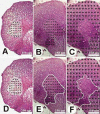Neuroprotective effects of methylprednisolone and hypothermia after experimental spinal cord injury: a histopathological and stereological study
- PMID: 25610097
- PMCID: PMC4261273
Neuroprotective effects of methylprednisolone and hypothermia after experimental spinal cord injury: a histopathological and stereological study
Abstract
Objective: Spinal cord injury is a common trauma among severe accidents in which the spinal cord has been severed; intravenous methylprednisolone and hypothermia are widely used in the treatment of traumatic spinal cord injuries. However, no common consensus has been reached on therapeutic approaches to prevent and reduce disability caused by spinal cord injuries. In this study, the efficacy of methylprednisolone and hypothermia treatments after experimental spinal cord injury made by dynamic weight-drop model in rabbits was investigated.
Materials and methods: This experiment consists of three groups: injured, methylprednisolone-treated and hypothermia-treated groups. The methylprednisolone-treated group received intravenous methylprednisolone (30 mg/kg/day) immediately after spinal cord injury for three days. In the hypothermia-treated group, cold isotonic saline (5°C) was infused via a cannula into the epidural space at a rate of 10 ml/min. The temperature of the tissue was allowed to reach 25ºC, and then isotonic saline solution was given at a rate of 5 ml/min for 3 hours. Saline was given to the injured group following spinal cord injury. After 1 week of experimental injury, mid-thoracic level tissue was removed from the spinal cord for histopathological evaluation and subsequent stereological analysis.
Results: The volume of spinal cord segment, not only parenchyma of grey and white matter but also cavity, was estimated by the Cavalieri principle. Significant differences were seen between the injured group and methylprednisolone /hypothermia-treated groups in terms of the total volume cavity of spinal cord segment; cavity volume in the grey matter and cavity volume in the white matter. No significant differences were seen between methylprednisolone and hypothermia-treated groups in terms of the total volume cavity of spinal cord segment; cavity volume in the grey matter and cavity volume in the white matter.
Conclusions: These results suggested that both methylprednisolone and hypothermia treatment are neuroprotective in preventing spinal cord tissue from tissue damage after experimental injury.
Amaç: Omurilik zedelenmesi, omuriliğin hasar gördüğü kazalar arasında yaygın bir travmadır. Damar içi metilprednizolon ve hipotermi, travmatik omurilik zedelenmesi tedavisinde yaygın olarak kullanılır. Ancak; omurilik zedelenmelerinin sebep olduğu özürlülüğü azaltan ve önleyen terapötik yaklaşımların üzerinde ortak bir uzlaşıya varılamamıştır. Bu çalışmada; tavşanlarda dinamik ağırlığı azaltma yöntemiyle yapılan deneysel omurilik zedelenmesinden sonra metilprednizolon ve hipotermi tedavilerinin etkinliği araştırılmıştır.
Gereç ve yöntem: Bu deney; yaralı grup, metilprednizolon ile tedavi edilmiş grup ve hipotermi ile tedavi edilmiş grup olmak üzere 3 gruptan oluşmuştur. Metilprednizolon ile tedavi edilmiş gruba, omurilik zedelenmesinden hemen sonra, üç gün boyunca damar içi metilprednizolon (30 mg/kg/gün) verilmiştir. Hipotermi ile tedavi edilmiş grup da, soğuk izotonik tuz çözeltisi (5°C), 10 ml/dk ’lik bir oranda kanula yoluyla epidural bölgeye enjekte edilmiştir. Doku ısısının 25°C ulaşmasına müsade edildi ve daha sonra izotonik tuz solüsyonu, üç saat boyunca 5 ml/dk ‘lik bir oranda verildi. Tuz çözeltisi, omurilik zedelenmesi olan yaralı gruba verildi. Deneysel zedelenmeden bir hafta sonra, omurilikten, histopatalojik değerlendirme ve sonrasındaki stereolojik analizler için orta torakal seviyedeki doku alındı.
Bulgular: Sadece gri ve ak cevherin parankimasının değil aynı zamanda kavitenin de bulunduğu omurilik segmentinin hacmi, Cavalieri Prensibi ile hesaplanmıştır. Beyaz cevherin kavite hacmi, gri cevherin kavite hacmi ve omurilik segmentinin total kavite hacmi yönünden, metilprednizolon/hipotermi ile tedavi edilmiş gruplar ve yaralı grup arasında anlamlı farklılıklar görüldü. Beyaz cevherin kavite hacmi, gri cevherin kavite hacmi ve omurilik segmentinin total kavite hacmi yönünden, metilprednizolon ve hipotermi ile tedavi edilmiş gruplar arasında anlamlı farklılıklar görülmedi.
Sonuç: Sonuçlar, hem metilprednizolon hem de hipotermi tedavilerinin, deneysel zedelenmeden sonra omurilik dokusunun, hasarlı dokulardan korunmasında nöroprotektif olduğunu ileri sürmüştür.
Keywords: Cavalieri principle; Experimental spinal cord injury; Hypothermia; Methylprednisolone; Stereology.
Figures








Similar articles
-
Effects of methylprednisolone on neuroprotective effects of delay hypothermia on spinal cord injury in rat.Asian Spine J. 2015 Feb;9(1):1-6. doi: 10.4184/asj.2015.9.1.1. Epub 2015 Feb 13. Asian Spine J. 2015. PMID: 25705328 Free PMC article.
-
[Effects of megadose methylprednisolone therapy on acute spinal cord injury in rats].Hokkaido Igaku Zasshi. 1994 Mar;69(2):236-47. Hokkaido Igaku Zasshi. 1994. PMID: 8157249 Japanese.
-
A comparison of adenosine A2A agonism and methylprednisolone in attenuating neuronal damage and improving functional outcome after experimental traumatic spinal cord injury in rabbits.J Neurosurg Spine. 2006 Jan;4(1):64-70. doi: 10.3171/spi.2006.4.1.64. J Neurosurg Spine. 2006. PMID: 16506468
-
Effect of a single huge dose of methylprednisolone on blood flow, evoked potentials, and histology after acute spinal cord injury in the rat.Neurol Res. 1997 Jun;19(3):289-99. doi: 10.1080/01616412.1997.11740815. Neurol Res. 1997. PMID: 9192382 Review.
-
Current therapeutic strategies for inflammation following traumatic spinal cord injury.Neural Regen Res. 2012 Aug 15;7(23):1812-21. doi: 10.3969/j.issn.1673-5374.2012.23.008. Neural Regen Res. 2012. PMID: 25624806 Free PMC article. Review.
Cited by
-
Ibrutinib reduces neutrophil infiltration, preserves neural tissue and enhances locomotor recovery in mouse contusion model of spinal cord injury.Anat Cell Biol. 2021 Sep 30;54(3):350-360. doi: 10.5115/acb.20.299. Anat Cell Biol. 2021. PMID: 34031271 Free PMC article.
References
-
- Delattre JY, Arbit E, Thaler HT, Rosenblum MK, Posner JB. A dose-response study of dexamethasone in a model of spinal cord compression caused by epidural tumor. J Neurosurg. 1989;70:920–5. - PubMed
-
- Merola A, O’Brien MF, Castro BA, et al. Histologic characterization of acute spinal cord injury treated with intravenous methylprednisolone. J Orthop Trauma. 2002;16:155–61. - PubMed
-
- Fukaya C, Katayama Y, Kasai M, Kurihara J, Maejima S, Yamamoto T. Evaluation of time-dependent spread of tissue damage in experimental spinal cord injury by killed-end evoked potential: effect of high-dose methylprednisolone. J Neurosur. 2003;98:56–62. - PubMed
-
- Inamasu J, Ichikizaki K. Mild hypothermia in neurologic emergency: an update. Ann Emerg Med. 2002;40:220–30. - PubMed
-
- Tetik O, Islamoglu F, Goncu T, Cekirdekci A, Buket S. Reduction of spinal cord injury with pentobarbital and hypothermia in a rabbit Model. Eur J Vasc Endovasc Surg. 2002;24:540–4. - PubMed
LinkOut - more resources
Full Text Sources
